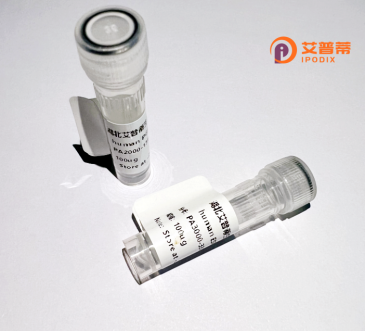
| 纯度 | >90%SDS-PAGE. |
| 种属 | Human |
| 靶点 | PPYR1 |
| Uniprot No | P50391 |
| 内毒素 | < 0.01EU/μg |
| 表达宿主 | E.coli |
| 表达区间 | 0 |
| 活性数据 | MNTSHLLALLLPKSPQGENRSKPLGTPYNFSEHCQDSVDVMVFIVTSYSIETVVGVLGNLCLMCVTVRQKEKANVTNLLIANLAFSDFLMCLLCQPLTAVYTIMDYWIFGETLCKMSAFIQCMSVTVSILSLVLVALERHQLIINPTGWKPSISQAYLGIVLIWVIACVLSLPFLANSILENVFHKNHSKALEFLADKVVCTESWPLAHHRTIYTTFLLLFQYCLPLGFILVCYARIYRRLQRQGRVFHKGTYSLRAGHMKQVNVVLVVMVVAFAVLWLPLHVFNSLEDWHHEAIPICHGNLIFLVCHLLAMASTCVNPFIYGFLNTNFKKEIKALVLTCQQSAPLEESEHLPLSTVHTEVSKGSLRLSGRSNPI |
| 分子量 | 42.2 kDa |
| 蛋白标签 | GST-tag at N-terminal |
| 缓冲液 | PBS, pH7.4, containing 0.01% SKL, 1mM DTT, 5% Trehalose and Proclin300. |
| 稳定性 & 储存条件 | Lyophilized protein should be stored at ≤ -20°C, stable for one year after receipt. Reconstituted protein solution can be stored at 2-8°C for 2-7 days. Aliquots of reconstituted samples are stable at ≤ -20°C for 3 months. |
| 复溶 | Always centrifuge tubes before opening.Do not mix by vortex or pipetting. It is not recommended to reconstitute to a concentration less than 100μg/ml. Dissolve the lyophilized protein in distilled water. Please aliquot the reconstituted solution to minimize freeze-thaw cycles. |
以下是3篇与重组人PPYR1(神经肽Y受体Y1)蛋白相关的文献信息及摘要要点:
---
1. **文献名称**:*Structural insights into ligand recognition of the human neuropeptide Y Y1 receptor*
**作者**:Yang, F. et al. (2021)
**摘要**:通过冷冻电镜解析人源PPYR1与神经肽Y复合物的三维结构,揭示其配体结合模式及受体激活机制,为靶向该受体的药物设计提供结构基础。
2. **文献名称**:*Functional characterization of recombinant human NPY Y1 receptor in lipid nanodiscs*
**作者**:Li, S. et al. (2019)
**摘要**:利用纳米盘技术重组表达人PPYR1.研究其在类膜环境中的构象动态变化,证明脂质环境对受体信号转导的关键调控作用。
3. **文献名称**:*Development of a high-throughput assay for PPYR1 receptor activation using recombinant human receptor-expressing cells*
**作者**:Müller, C.E. & Keller, J. (2017)
**摘要**:构建稳定表达重组人PPYR1的HEK293细胞系,开发高通量筛选方法,用于筛选靶向该受体的抗肥胖症候选化合物。
---
**备注**:PPYR1(Neuropeptide Y Receptor Y1)的研究多聚焦于其在代谢、肥胖及癌症中的作用,上述文献覆盖结构生物学、功能研究和药物开发方向。若需扩展,建议结合具体应用场景进一步筛选。
**Background of Recombinant Human PPYR1 Protein**
The recombinant human Protein-coupled receptor PY1 (PPYR1), also known as Neuropeptide Y receptor Y4 (NPY4R), belongs to the G protein-coupled receptor (GPCR) family. It primarily interacts with pancreatic polypeptide (PP), a gut hormone involved in regulating energy homeostasis, appetite, and gastrointestinal functions. Structurally, PPYR1 contains seven transmembrane domains and signals through Gαi/o proteins, inhibiting cAMP production upon activation.
PPYR1 is expressed in the brain, pancreas, and digestive tract, playing roles in metabolic regulation and satiety signaling. Its dysfunction has been linked to obesity, diabetes, and eating disorders, making it a potential therapeutic target. Recombinant PPYR1 protein, produced via expression systems like mammalian cells (e.g., HEK293 or CHO cells) or *E. coli* (for non-glycosylated forms), retains ligand-binding activity and structural integrity for *in vitro* studies.
This protein is widely used in drug discovery to screen agonists/antagonists, study receptor-ligand interactions (e.g., via SPR or cryo-EM), and explore signaling pathways. Its recombinant form enables high-purity, scalable production, facilitating research into metabolic diseases and novel treatments. Advances in PPYR1 research may shed light on central nervous system disorders and gut-brain axis mechanisms.
×